
 |
| VOICES WEST: SEX IN THE WEST COWBOY-RELATED DOCUMENTS |
| Sex
in the West Bibliography: Galloway - Hurtado |
[Homepage] [Introduction] [Cowboy Poetry] [Cowboy Songs] [Postcards]
* Indicates from the collection of Alan V. Miller
Galloway, David. "Up yours, Tonto!" or, growing up queer in America." p.208-218. In The sex industry. Edited by George Paul Csicsery. New York: New American Library, 1973.
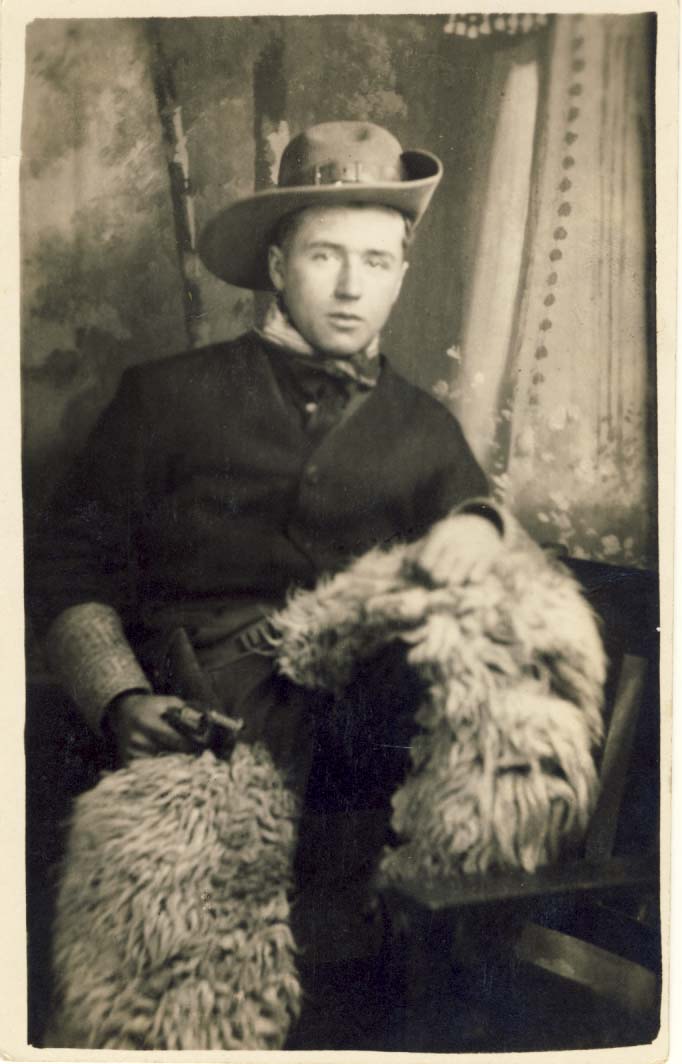 |
" Clément Marchand." n.p. [1910s] AZO. [Four triangles pointing up in AZO square] Signed on back of Real photo postcard |
* Garceau, Dee. "Nomads, bunkies, cross-dressers, and family men: cowboy identity and the gendering of ranch work." p.149-168. In Across the great divide: cultures of manhood in the American West. Edited by Matthew Basso, Laura McCall and Dee Garceau. New York: Routledge, 2001. 308 p.
"Memoirs and folk songs from the open-range era depict an all-male culture with distinctive freedoms. Sexual license, nonmarital intimacy with women, close relationships with men, and playful cross-dressing were among the masculine privileges enjoyed by these livestock herders." p.153
"Cowboys sometimes parodied gender identity with episodes of cross-dressing. Freedom from middle-class social convention was freedom to make ribald fun of Victorian gender norms. This lay at the core of cowboy cross-dressing. Occasionally, men would take the female role socially, in order to form couples for a dance where no women were present. At these times, a cowboy dressed normally, the only feminine marker being a scarf tied to his arm to signal his place in the dance as a women." p.160
In footnote 36, Garceau notes that of the seventeen cowboy narratives surveyed, only one hinted at homoerotic affection, Andy Adams's The log of a cowboy : a narrative of the old trail days. (See Lincoln, NB: University of Nebraska Press, 1964, c1903.) Also mentioned is a song about a young woman passing as a youth, Powder River Jack Lee's, "The stampede: the Cherokee Kid from the Cimmarron Strip." And a cross-dressing cowboy recalled by Ike Blasingame.
Garde, Noel I. "The first native American 'gay' novel." One Institute quarterly of homophile studies. 9: 185-190, Spring 1960.
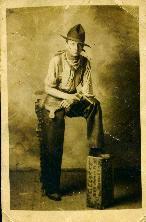 |
"Clarke's Studio" C.
Clarke Studio |
Gay and lesbian histories exhibit, April 20 - May 2, 1993, Stables Arts Center. Washington, D.C.: One in Ten, 1993.
Gay and lesbian literary heritage: a reader's companion to the writers and their works, from antiquity to the present. Edited by Claude J. Summers. New York: Henry Holt, 1995.
Gay warriors: a documentary history from the ancient world to the present. Edited by B.R. Burg. New York: New York University Press, 2002. 432 p.
The book includes material on Walt Whitman and the American Civil War and the Newport, Rhode Island investigations.
* Gibson, Arrell Morgan. The Sante Fe and Taos colonies: age of the muses, 1900-1942. Norman, OK: University of Oklahoma Press, 1983. 305 p.
"Gay status became a common and accepted form of sexual choice in both colonies, albeit a subject of continuing ridicule in the press -- a Santa Fe New Mexican 'Village gossip' column in 1931 stated: 'Wanted, information leading to disclosure of the indentity of the unprincipled person who sent Santa Fe's leading novelist a cake of Fairy Soap on Wednesday." p.198
* Gibson, Margaret. "Clitoral corruption: body metaphors and American doctors' constructions of female homosexuality, 1870-1900." p.108-132. In Science and homosexualities. Edited by Vernon A. Rosario. New York: Routledge, 1997.
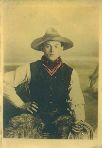 |
[Unknown man] Hand
tinted. |
* Gifford, James. Dayneford's library: American homosexual writing, 1900-1913 / James Gifford. Amherst, MA: University of Massachusetts Press, 1995. 153 p.
* Gifford, James. "Left to themselves: the subversive boys books of Edward Prime-Stevenson (1858-1942)." Journal of American and comparative cultures. Fall-Winter 2001, p.113-116.
Edward Prime-Stevenson, whose pseudonym was Xavier Mayne, wrote Imre: a memorandum (1906), and The intersexes (1908). He became one of the first American authors to write on homosexuality and in response to the morbid medical model.
Gilbert, Arthur N. "Doctor, patient and onanist diseases in the nineteenth century." Journal of the history of medicine. 30 : 217, 1975.
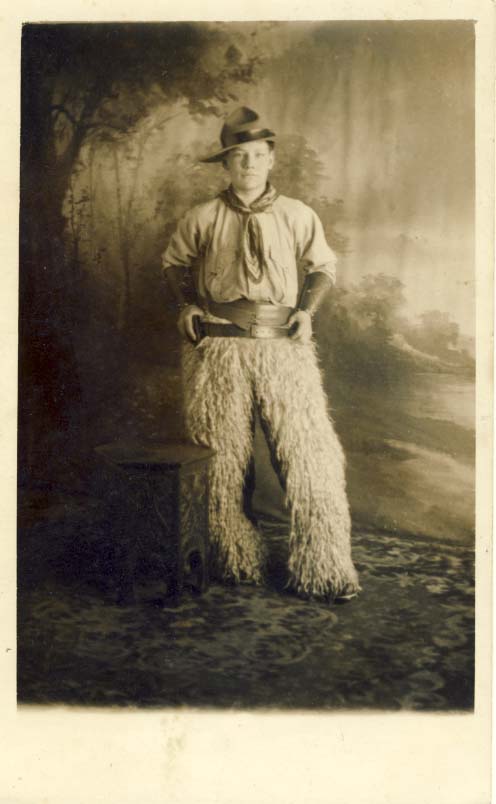 |
"S. Charnell Studio" S.
Charnell |
* Gilfoyle, Timothy J. "Policing of sexuality." ch.14, p.297-314. In Inventing Times Square: commerce and culture at the crossroads of the world, 1880-1939. Edited by William R. Taylor. New York: Russell Sage Foundation, 1991.
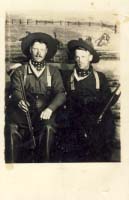 |
[2 men with rifles] [Canada], n.p., 191- "Made in Canada." "AZO." Real photo postcard |
* Gilmartin, Katie. “'We weren't bar people': middle-class lesbian identities and cultural spaces.” GLQ 3(1): 1-51, 1996.
Based on her PhD dissertation, Gilmartin, Kate. “The very house of difference: intersections of identities in the life histories of Colorado lesbians, 1940-1965.” PhD, Yale University, 1995.
* Gorn, Elliott J. The manly art: bare-knuckle prize fighting in America / Elliott J. Gorn. Ithaca, NY: Cornell University Press, 1986. 316 p.
"Sociologists have talked of a 'bachelor subculture' to capture a phenomenon so common to nineteenth- and early twentieth-century cities: large numbers of unmarried males finding their primary human contact in one another's company. In some large cities unweddedness was so common that at mid-century, 40 percent of men between twenty-five and thirty-five years of age were single ... With the breakdown of the household economy, men and women spent diminishing amounts of their work time together, and many chose to take their leisure too in gender-segregated realms." p.141.
"There was a parallel in the bachelor subculture that supported the ring. Of course heterosexual prowess was an important element of masculinity; fathering a family, picking up unattached women, and frequenting prostitutes all demonstrated virility. But maleness seemed most emphatically confirmed in the company not of women, but of other men. The loving descriptions of boxers' bodies so common in antebellum fight reports grew less from narrowly defined homosexuality than from a common male aesthetic. Men perceived men as creatures of beauty because they focused so much emotional attention on one another." p.142.
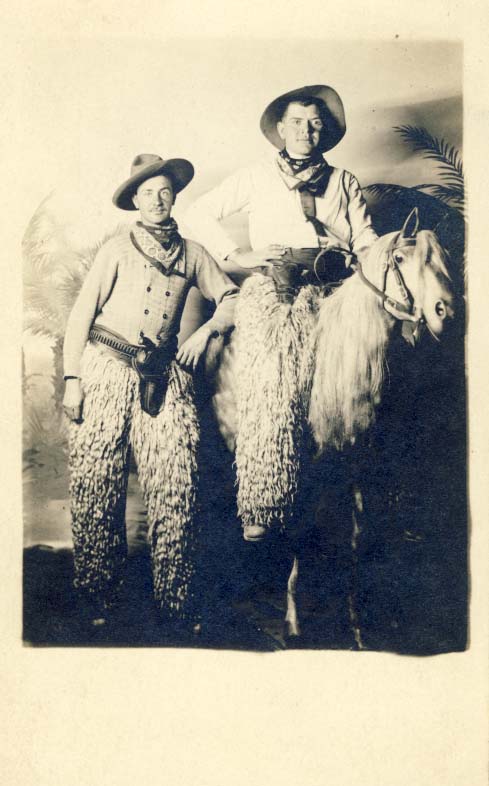 |
[2 men, both in chaps, one on fake horse]. [U.S.A.: 1900s] Real photo postcard |
Gould, Mitch. "Singing solitary in the West: Walt Whitman's cowboy counterparts." Roundup. December 1995.
Grahn, Judy. "Boys at the rodeo." In True to life adventure stories. Vol. 2. Trumansburg, NY: Crossing Press, 1981.
Grant, George Paul. The poetic development of John G. Neihardt / George Paul Grant. PhD dissertation. University of Pittsburgh, 1958.
* Green, Harvey. Fit for America: health, fitness, sport and American society. Baltimore; London: The Johns Hopkins University Press, 1986. 367 p. (Reprint: New York: Pantheon Books, 1986.)
Includes material for the period 1830-1940. See index: "Sexuality" p.364.
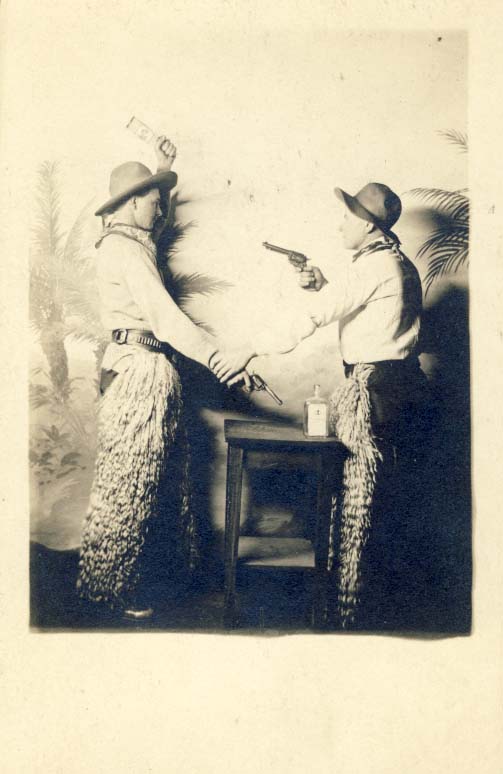 |
[Same 2 men, both in chaps, one with bottle raised and the other with gun pointed at him]. [U.S.A.: 1900s] Real photo postcard |
* Greenhill, Pauline. "'The handsome cabin boy': cross-dressing ballads, sexualities, and gendered meanings." p.113-130. In Undisciplined women: tradition and culture in Canada. Edited by Pauline Greenhill and Diane Tye. Montreal, QC; Kingston, ON: McGill-Queen's University Press, 1997. 306 p.
"I'm arguing here for an interpretation of songs' meanings based on current as well as possible historical understandings: specifically, that messages they contain about the action and behaviour they depict may not be exclusively heterosexual ... Thus whether or not their original or current singers see these songs as pertaining to homosexuality, some audiences, then as now, may so interpret them." p.116
* Griffey, Randall R. "Encoding the homoerotic: Marsden Hartley's late figure paintings." p.207-237, including plates 71-88. In Marsden Hartley. Edited by Elizabeth Mankin Kornhauser. New Haven, CT: Wadsworth Atheneum Museum of Art ; Hartford CT; London: Yale University Press, 2002.
Hartley hid his homosexuality, but the early Berlin paintings, and the late portrait remembrances of the Masons, a Nova Scotia family, whose sons Alty and Donny he befriended, reveal how much of a risk he was willing to take in exhibiting these.
Guerin, Mrs. E. J. Mountain Charley: or the adventures of Mrs. E.J. Guerin, who was thirteen years in male attire. Norman, OK: University of Oklahoma Press, 1986.
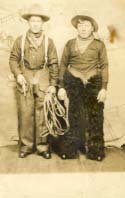 |
[2 men, one with gun and rope, other in chaps] [Duluth, MN.]: Wide Awake Studio, [1913]. Real photo postcard |
* Gustav-Wrathall, John Donald. Take the young stranger by the hand: same-sex relations and the YMCA / John Donald Gustav-Wrathall. Chicago, IL: University of Chicago Press, 1998. 267 p.
* Guttman, Jon. "The Wilde west." Wild West 5(1): 43, June 1992.
On Oscar Wilde's 1882 tour of the American west, especially on his time in Denver and Leadville, Colorado.
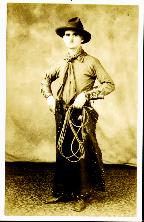 |
"International Studio" International
Studio |
Hall, Richard. Patriots in disguise: women warriors of the Civil War / Richard Hall. New York: Paragon House, 1993. 224 p.
* Hajdu, David. "A jazz of their own." Vanity Fair. 465: 188-196, May 1999.
Hajdu, David. Lush life: a biography of Billy Strayhorn / David Hajdu. New York: Farrar, Straus, Giroux, 1996.
Hall, Richard. Patriots in disguise: women warriors of the Civil War. New York: Paragon House, 1993. 224 p.
"Passing women" in the American Civil War. See ch.6 "Sarah Emma Edmonds: childhood and youth" p.74-82 (Edmonds was from Canada, author of Nurse and spy in the Union Army, 1865); ch.13 "The legend of 'Mountain Charley'" p.167-177.
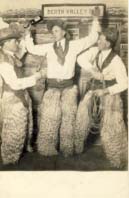 |
[3 men, left one with gun, middle one with bottle, right one with rope, all in chaps] [Canada, 191-] "Made in Canada." AZO Real photo postcard, Death Valley Inn. |
* Hammond, Dorothy; Jablow, Alta. "Gilgamesh and the Sundance Kid: the myth of male friendship." p.241-258. In The making of masculinities. Edited by Harry Brod. London: Allen and Unwin, 1987.
"The modern protagonists, often heroes in spite of themselves, are usually of the lower class: common soldiers, seamen, prospectors, cowboys, criminals and policemen. Their dangerous occupations provide the arena for the drama of friendship." p.252.
"Men in other dangerous or isolated situations form friendships like those of soldiers. Henry Lawson, 'The Poet of the Outback' eulogized the 'mateship' of Australian gold prospectors ... 'which helped bind men together in a mystical friendship ... continued, ideally, until death'." p.253.
* Handley, William R. "Wister's omniscience and omissions." p.39-71. In Reading ‘The Virginian' in the new West. Edited by Melody Graulich and Stephen Tatum. Lincoln: University of Nebraska Press, 2003.
"For Wister, such sacrifice likely involved the repression of something between homosocial desire and same-sex love, the suggestive evidence of which is made especially ambiguous by the silence surrounding it in Wister's time. It is unlikely that even if Wister had not killed off these feelings but 'gotten to know himself,' as Tompkins wryly puts it, either in Europe studying music or among his fellow nomadic, bachelor cowboys, he would have ultimately avoided the 'housed, married' life that he came to know. Evidence for Wister's deep affections toward the same sex has primarily been located in those textural moments when the narrator, with whom the author aligns himself, describes the Virginian's beauty or imagines himself as a woman easily seduced by him. Jane Tompkins and Blake Allmendinger also read this possibility into the special relationship ..." p.52
Handley next describes the complicated friendship between George West and Wister.
 |
[Single man with rifle and rope over right shoulder]. Toronto: Queen Studio, 1900s. Real photo postcard |
* Hansen, Bert. "American physicians' 'discovery' of homosexuals, 1880-1900: a new diagnosis in a changing society." p.104-133. In Framing disease: studies in cultural history. Edited by Charles E. Rosenberg and Janet Golden. New Brunswick, NJ: Rutgers University Press, 1992.
* Hansen, Bert. "The historical construction of homosexuality." Radical history review. 20: 66-73, Spring/Summer 1979. Their special "Sexuality in history" issue.
Hansen, in part, uses Jeffrey Weeks' Coming Out to expand on Mary McIntosh's conceptualizaton of the historical emergence of a "homosexual role," 1890s to 1960s.
 |
[Man with rifle sitting on a barrel]. [U.S.A.: 1900s] Real photo postcard |
* Hansen, Bert. "Public careers and private sexuality: some gay and lesbian lives in the history of medicine and public health." American journal of public health. 92(1): 36-44, January 2002.
The recovery of 5 individuals who were active in the first half of the 20th century. Lives that today might be labelled: gay, lesbian, bisexual, transgendered. These include: Sara J. Baker, Harry S. Sullivan, Ethel C. Dunham, Martha M. Eliot and Alan L. Hart.
Hantover, Jeffrey P. "The Boy Scouts and the validation of masculinity." In The American man. Edited by Elizabeth Pleck and Joseph H. Pleck. Englewood Cliffs, NJ: Prentice-Hall, 1980. See p.285-301.
Hantover, Jeffrey P. Sex role, sexuality and social status: the early years of the Boy Scouts of America / Jeffrey P. Hantover. PhD dissertation, University of Chicago, 1976. See p.288.
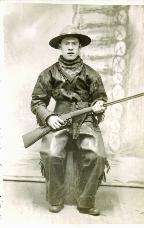 |
"Queen Studio" Queen
Studio |
Hartland, Claude. The story of a life / Claude Hartland. San Francisco, CA: Grey Fox, 1985, c1901.
Hartland's experiences as a sexual invert in St. Louis, Missouri to 1901. See also Adam Sonstegard and Jay Hatheway.
* Haskell, Barbara. Charles Demuth / Barbara Haskell. New York: Whitney Museum of American Art, in association with Henry N. Abrams, 1987. 240 p. (See also Jonathan Weinberg.)
One of the best biographies, to accompany an exhibition, on the artist Charles Demuth (1883-1935), dealing with his homosexuality, friendship with Marsden Hartley, and others, and self-suppression of some of his homoerotic art.
"Vaudeville was particularly suited to Demuth, for its integration of the spoken word with visual effects appealed to him as a playwright. Too, vaudeville's hiring of female impersonators (who drew a homosexual audience) made it, for Demuth, a subject simultaneously illicit and safe." p.53.
"By 1932 the overtness of this series seems to have run its course, for Demuth retreated to the camouflaged sexual innuendos of earlier years. "On 'That' Street" (pl.108) could easily pass for a casual conversation between dandy and sailor if 'that' street had not been rumored to refer to Sand Street in Brooklyn, a well-known site of homosexual assignations." p.207.
 |
[Man in hat wearing suspenders, holding horse reins.] [U.S.A.: 1900s] Photo postcard
|
* Hatheway, Jay. "Book reviews: [review of Gay warriors edited by B.R. Burg]." Committee on Lesbian and Gay History (CLGH) Newsletter. 17(1): 9- 10, Spring 2003.
The book includes material on Walt Whitman and the American Civil War and the Newport, Rhode Island investigations.
* Hatheway, Jay. The Gilded Age construction of modern American homophobia / Jay Hatheway. New York: Palgrave Macmillan, 2003. 232 p.
See: ch.3 "Nineteen-century gay America" p.49-60; "ch.10 "An emerging homosexual identity during the Gilded Age" p.157-177, delving into Claude Hartland's The Story of a Life.
* Hatt, Michael. "‘Making a man of him': masculinity and the Black body in mid-nineteenth-century American sculpture." Oxford art journal. 15(1): 21-35, 1992.
Good treatment of the lives of African American men and effects of the Civil War, being "their first point of entry into the realm of the homosocial." p.24
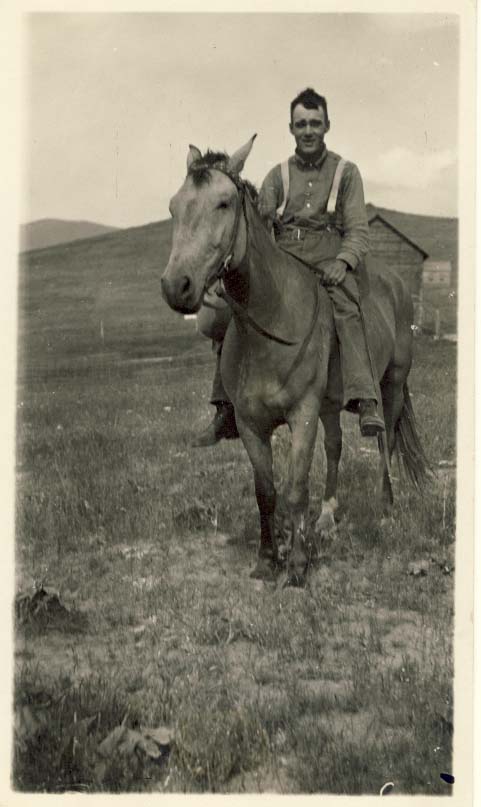 |
[Same man from above wearing suspenders, without hat, on his horse.] [U.S.A.: 1900s] Photo postcard
|
* Hazard, Lucy Lockwood. The frontier American literature / Lucy Lockwood Hazard. New York: Thomas Crowell, 1927. 308 p.
Henry, Stuart. Conquering our great American plain: a historical development / Stuart Henry. New York: Dutton, 1930.
Hidden from history: reclaiming the gay and lesbian past. Edited by Martin Duberman, Martha Vicinus and George Chauncey. New York: New American Library, 1989. 579 p.
 |
"Cowboy costume, Canadian" No
place [?Montreal, Que.] |
* Hine, Robert V. "The cowboy and the cult of masculinity." p.125-138. In The American West: an interpretive history. Boston, MA: Little, Brown, and Co., 1973. 371 p.
* Hine, Robert V.; Faragher, John Mack. "The open range." Ch.10, p.301-329. In The American West: an new interpretive history. New Haven, CT: Yale University Press, 2000. 616 p.
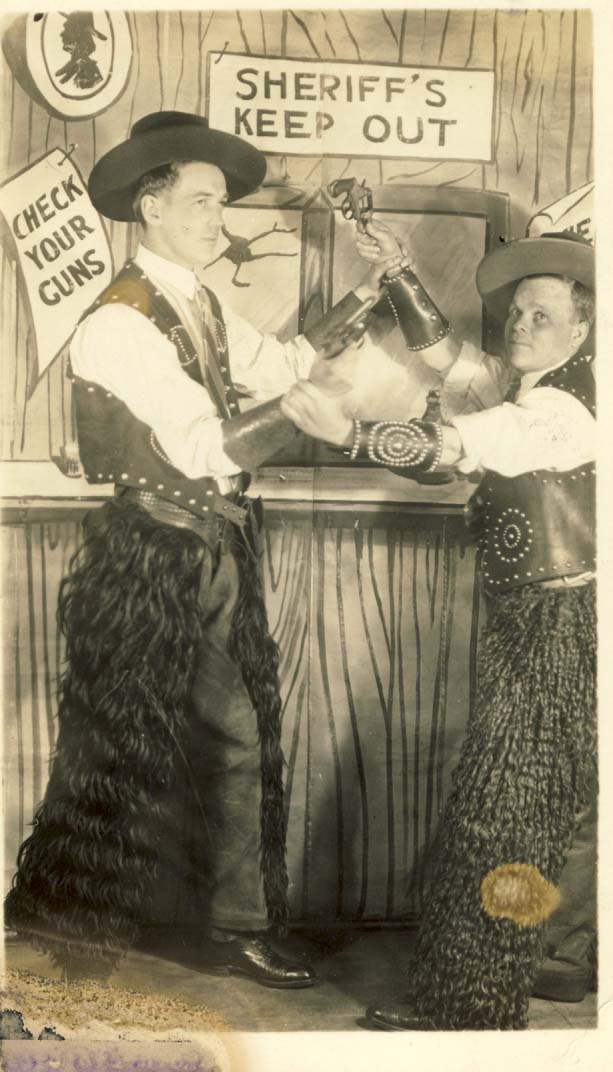 |
"Bill Dickson." n.p. [April 1931] Real photo postcard. Signed on back: From Wild Bill Dickson Sheriff's keep out: Check your guns. |
Hoffman, Andrew Jay. Inventing Mark Twain : the lives of Samuel Langhorne Clemens / Andrew Jay Hoffman. New York: W. Morrow, c1997. 572 p.
* Hoffman, Andrew J. "Mark Twain and homosexuality." American literature. 67(1): 23-49, March 1995.
"Merely suggesting the possibility of Clemens's homosexual experience has provoked debate and, in some cases, personal attack. One cannot alter the visage of an icon without retribution. People both in and outside academia have sprung to the defense of Mark Twain's reputation, treating my hypothesis about his sexuality as though it were an attack on his character." p.25.
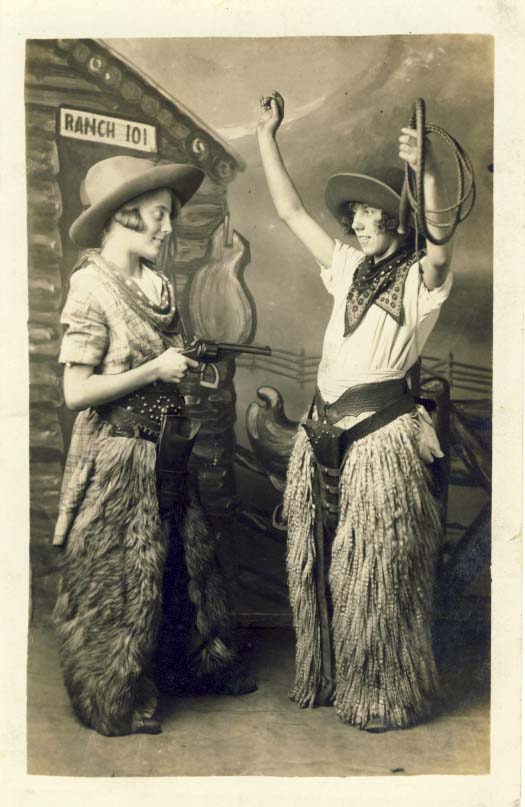 |
"[Ranch 101, two women dressed as cowgirls, one with gun, other with whip held in air.]" n.p., Made in Canada |
* Hoffman, Frederick J. Freudianism and the literary mind / Frederick J. Hoffman. Westport, CT: Greenwood Press, 1977, c1945. 350 p.
"But many, if not all, of the intellectuals of the twenties thought of the revolt as one for the present at least dominated by a personal soul-searching and a mind so free and so open that it could quite freely entertain contradictory theories without being upset in the slightest. Psychoanalysis suited most of them because it was new, unorthodox, shockingly frank, and because it implied - though it certainly did not advise - a more liberal view of sex matters." p.73.
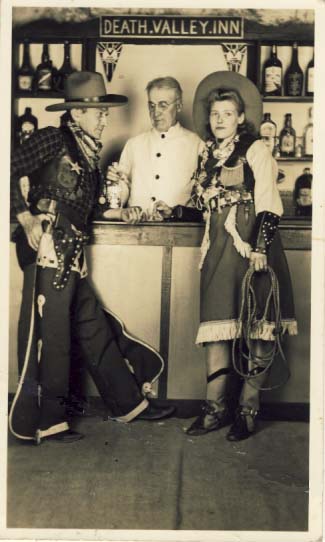 |
"Death Valley Inn." n.p. [1930s] "Made in Canada." AZO. [Four squares pointing up in AZO square] Real photo postcard of cowboy and cowgirl with drinks at bar. |
* Hogrefe, Jeffrey. O'Keeffe: the life of an American legend / by Jeffrey Hogrefe. New York: Bantam Books, 1992. 376 p.
"Like many repressed homosexuals, O'Keeffe appears to have been ashamed of her attraction to people of the same sex and taken measures to cover her sexual inclination with smokescreens. Some of her closest friends as well as family members have denied knowing that the artist had women lovers; and, in fact, some of them have insisted emphatically that she was not a lesbian -- protesting a little too loudly for people who did not really know her private life." p.27
Hogrefe will later use the word "bisexuality" (p.155), which is probably still not what Georgia O'Keeffe used to identify her own complicated sexuality.
* Holditch, W. Kenneth. "William Spratling, William Faulkner and other famous Creoles." Mississippi quarterly. 51(3): 423-435, Summer 1998.
William Spratling lived in New Orleans in the early 1920s, and in 1929 moved to Taxco, Mexico, and reestablished the silver industry there. While in New Orleans he befriended Sherwood and Elizabeth Anderson, William Faulkner, Oliver LaFarge, Natalie Scott, and others. (See also biographies by Joan Mark and Taylor D. Littleton)
"Frederick Karl may, of course, have believed Spratling's homosexuality made him an 'outsider,' but that, in of itself, has never been sufficient cause in New Orleans to exclude one socially ... Residents speak jokingly of what is termed an 'Uptown marriage,' a not-uncommon union in which a gay man, born into New Orleans society, marries an appropriate debutante ..."
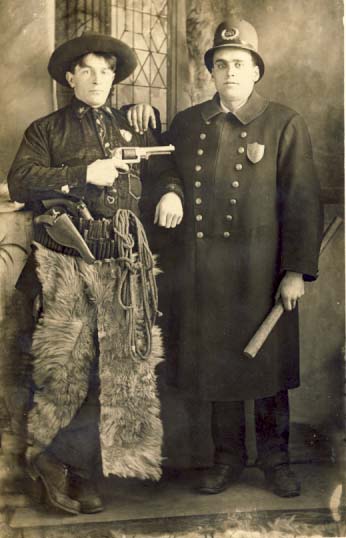 |
"Price, Murray." [2 men: cowboy and policeman] |
* Hole, Heather. Marsden Hartley and the West: the search for an American modernism. Preface by Barbara Buhler Lynes. New Haven, CT: Yale University Press; Santa Fe, NM; Georgia O'Keeffe Museum, 2007. 166 p.
"Hartley disliked most of the artists who had lived in Taos for a long period of time, and was disliked by them in turn. He wrote, 'Then too, outside of the few charming people, like Mrs. C., Maurice and Mabel S[terne] , [and] Leo S[tein], which is of course rare to find in a far away place, the rest of the people are simply impossible, dreadful painters, who are just nasty tongued, and talking all the time about someone.' " p.41
See Index for "homosexuality," and Thomas Hart Benton's homophobic quote from his 1937 memoir, "I imagine it will be quite a time before artistic New Mexico lives down the influx of gabbling and vain women, of priggish aesthetes, minor poets, and fairies which followed the War." p.147
* Horrocks, Roger. Masculinity in crisis: myths, fantasies and realities / by Roger Horrocks. New York: St. Martin's Press, 1994. 210 p. See ch.9: "Male images and stereotypes," p.143-166.
"Westerns: The most significant film genre describing male love is undoubtedly the western, which became increasingly sadistic and quasi-psychotic in the post-sixties period. The directors Sergio Leone and Sam Peckinpah developed a luxuriant eroticism of violence, photographed with stylistic bravura." p.151.
"The look is crucial - in many westerns, men continually stare at each other, held in each other's gaze with a passionate intensity quite different from their regard for women. At the beginning of Shane, Alan Ladd says to the young boy who worships him: 'I like a man who watches things going round. Shows he'll make his mark some day.' Men watch and wait upon each other, ready for the climatic moment, when they find love - or death. And there seems little difference between the two - since male love cannot be found in life, it must be found in death." p.152-153.
* Houlbrook, Matt. Queer London: perils and pleasures in the sexual metropolis, 1918-1957. Chicago: University of Chicago Press, 2005. 384pp. Sources include police reports, newspaper articles, correspondence, diaries and printed sources. Sections include Policing, Places, People and Politics.
House, Julius T. John G. Neihardt, man and poet / Julius T. House. Wayne, NB: F.H. Jones, 1920.
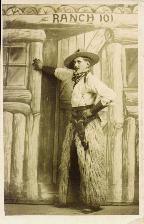 |
"Clark's Studio" Clark's
Studio |
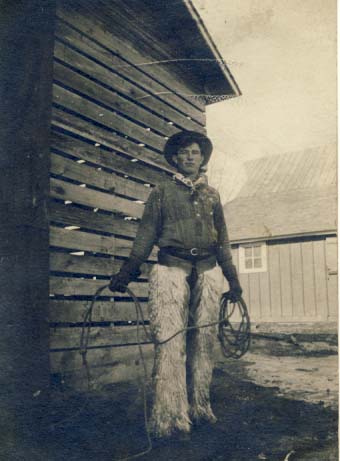 |
"[1 man, cowboy in chaps and holding rope.]"
C & Ko. Real photo postcard.
|
Hughes, Charles H. "Homo sexual complexion perverts in St. Louis: note on a feature of sexual psychpathy." Alienist and neurologist 28(4): 487-488, November 1907.
"Male negroes masquerading in women's garb and carousing and dancing with white men is the latest St. Louis record of neurotic and psychopathic sexual perversion ... All were gowned as women at the miscegenation dance and the negroes called each other feminine names ... The names of these negro perverts, their feminine aliases and addresses appear in the press notices of their arrest, but the names of the white degenerates consorting with them are not given." (From Katz 1976, p.48-49)
Hurewitz, Daniel. Bohemian Los Angeles and the making of modern politics / Daniel Hurewitz. Berkeley, CA: University of California Press, 2007. 369 p.
Three communities, from the 1920s to 1960s, of the Edendale area are discussed: artists, leftists and gay men and lesbians. Of interest are sections on Julian Eltinge, Harry Hay and the Mattachine Society.
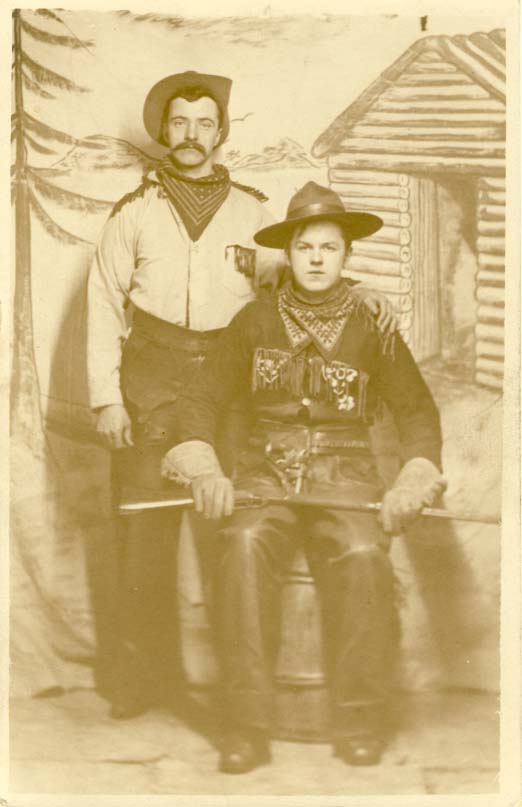 |
* Two men, one standing with hand on the other's shoulder, second one seated with rifle over legs. Toronto: Queen Studio, 1900s. Real photo postcard |
* Hurtado, Albert L. Intimate frontiers: sex, gender, and culture in old California / Albert L. Hurtado. Albuquerque, NM: University of New Mexico Press, 1999. 173 p.
* Hurtado, Albert L. "When strangers met: sex and gender on three frontiers." p.122-142. In Writing the range: race, class, and culture in the women's West. Edited by Elizabeth Jameson & Susan Armitage. Norman, OK: University of Oklahoma Press, 1997. 656 p.
This is specifically about Indian-White sex and gender relations, but the berdache is also covered. "Religious and lay Spaniards alike, who considered homosexuality an execrable sin against nature, one to be extirpated at all cost, had no other sexual framework within which to understand Indian' cross-gender roles. Much to the dismay of Spaniards, berdache Indians were ubiquitous in California." p.127.
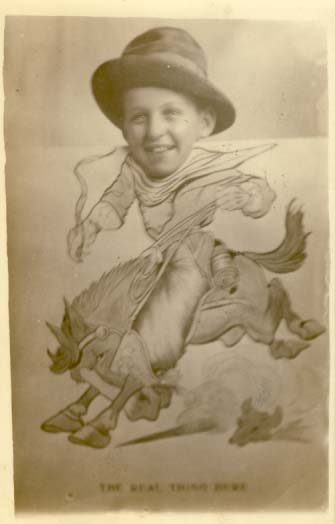 |
"The real thing here." Boston, MA: Avery Photo Postal Studio, [1913]. Real photo postcard. "Dear Mrs. Burtt. Thought I would send you one of my pictures. Bayard." |
Hurtado, Al. "Sexuality in the California missions: cultural perceptions and sad realities." California History. 71 : 371-385, 451-453, Fall 1992.
[Sex in the West Introduction] [Contents] [Previous page] [Next page]
 |
"Whereof the shining goal was comradeship." |
| Contact owner: Alan V. Miller at millera@cowboysong.com | |
| Last revised: January 24, 2013 |